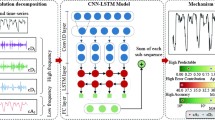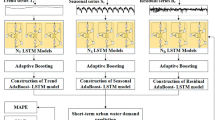Abstract
Predicting urban water demand is important in rationalizing water allocation and building smart cities. Influenced by multifarious factors, water demand is with high-frequency noise and complex patterns. It is difficult for a single learner to predict the nonlinear water demand time series. Therefore, ensemble learning is introduced in this work to predict water demand. A model (Word-embedded Temporal Feature Network, WE-TFN) for predicting water demand influenced by complex factors is proposed as a base learner. Besides, the seasonal time series model and the Principal Component Analysis and Temporal Convolutional Network (PCA-TCN) are combined with WE-TFN for ensemble learning. Based on the water demand data set provided by the Shenzhen Open Data Innovation Contest (SODIC), WE-TFN is compared with some typical models. The experimental results show that WE-TFN performs well in fitting local extreme values and predicting volatility. The ensemble learning method declines by approximately 68.73% on average on the Root Mean Square Error (RMSE) compared with a single base learner. Overall, WE-TFN and the ensemble learning method outperform baselines and perform well in water demand prediction.









Similar content being viewed by others
Availability of Data and Materials
The data and materials are available from the corresponding author upon reasonable request.
References
Abu-Bakar H, Williams L, Hallett SH (2021) A review of household water demand management and consumption measurement. J Clean Prod 292:125872. https://doi.org/10.1016/j.jclepro.2021.125872
Adamowski J, Adamowski K, Prokoph A (2013) A spectral analysis based methodology to detect climatological influences on daily urban water demand. Math Geosci 45:49–68. https://doi.org/10.1007/s11004-012-9427-0
Alamanos A, Sfyris S, Fafoutis C et al (2020) Urban water demand assessment for sustainable water resources management, under climate change and socioeconomic changes. Water Supply 20:679–687. https://doi.org/10.2166/ws.2019.199
Antonopoulos VZ, Gianniou SK (2022) Analysis and modelling of temperature at the water – atmosphere interface of a lake by energy budget and ANNs models. Environ Process 9:1–20. https://doi.org/10.1007/s40710-022-00572-0
Awadh SM, Al-Mimar H, Yaseen ZM (2021) Groundwater availability and water demand sustainability over the upper mega aquifers of Arabian Peninsula and west region of Iraq. Environ Dev Sustain 23:1–21. https://doi.org/10.1007/s10668-019-00578-z
Babel MS, Maporn N, Shinde VR (2014) Incorporating future climatic and socioeconomic variables in water demand forecasting: a case study in Bangkok. Water Resour Manag 28:2049–2062. https://doi.org/10.1007/s11269-014-0598-y
Bakker M, Van DH, Van SK et al (2014) Improving the performance of water demand predicting models by using weather input. Procedia Eng 70:93–102. https://doi.org/10.1016/j.proeng.2014.02.012
Baldauf S, Porada P, Raggio J et al (2021) Relative humidity predominantly determines long-term biocrust-forming lichen cover in drylands under climate change. J Ecol 109:1370–1385. https://doi.org/10.1111/1365-2745.13563
Banik R, Das P, Ray S et al (2020) Wind power generation probabilistic modeling using ensemble learning techniques. Mater Today 26:2157–2162. https://doi.org/10.1016/j.matpr.2020.02.464
Brown TC, Mahat V, Ramirez JA (2019) Adaptation to future water shortages in the United States caused by population growth and climate change. Earth’s Future 7:219–234. https://doi.org/10.1029/2018EF001091
Candelieri A, Giordani I, Archetti F et al (2019) Tuning hyperparameters of a SVM-based water demand predicting system through parallel global optimization. Comput Oper Res 106:202–209. https://doi.org/10.1016/j.cor.2018.01.013
Divina F, Gilson A, Goméz-Vela F et al (2018) Stacking ensemble learning for short-term electricity consumption predicting. Energies 11:949–979. https://doi.org/10.3390/en11040949
Driesen E, Van den Ende W, De Proft M et al (2020) Influence of environmental factors light, CO2, temperature, and relative humidity on stomatal opening and development: A review. Agronomy 10:1975–2002. https://doi.org/10.3390/agronomy10121975
Guo G, Liu S, Wu Y et al (2018) Short-term water demand forecast based on deep learning method. J Water Res Plan Man 144:66–76. https://doi.org/10.1061/(ASCE)WR.1943-5452.0000992
Luna T, Ribau J, Figueiredo D et al (2019) Improving energy efficiency in water supply systems with pump scheduling optimization. J Clean Prod 213:342–356. https://doi.org/10.1016/j.jclepro.2018.12.190
Lv Z, Li J, Dong C et al (2021) Deep learning in the COVID-19 epidemic: A deep model for urban traffic revitalization index. Data Knowl Eng 2021:101912. https://doi.org/10.1016/j.datak.2021.101912
Nie W, Zaitchik BF, Rodell M et al (2021) Irrigation water demand sensitivity to climate variability across the contiguous United States. Water Resour Res 57:2020WR027738. https://doi.org/10.1029/2020WR027738
Niknam A, Zare HK, Hosseininasab H et al (2022) A critical review of short-term water demand forecasting tools—what method should I use? Sustainability 14:5412–5436. https://doi.org/10.3390/su14095412
Ning T, Zhou S, Chang F et al (2019) Interaction of vegetation, climate and topography on evapotranspiration modelling at different time scales within the Budyko framework. Agr Forest Meteorol 275:59–68. https://doi.org/10.1016/j.agrformet.2019.05.001
Niu Z, Wang C, Zhang Y et al (2018) Leakage rate model of urban water supply networks using principal component regression analysis. Trans Tianjin Univ 24:172–181. https://doi.org/10.1007/s12209-017-0090-x
Olsson G (2021) Urban water supply automation–today and tomorrow. J Water Supply Res T 70:420–437. https://doi.org/10.2166/aqua.2020.115
Perea RG, Ballesteros R, Ortega JF et al (2021) Water and energy demand forecasting in large-scale water distribution networks for irrigation using open data and machine learning algorithms. Comput Electron Agric 188:1–13. https://doi.org/10.1016/j.compag.2021.106327
Santos AV, Couto CF, Lebron YAR et al (2020) Occurrence and risk assessment of pharmaceutically active compounds in water supply systems in Brazil. Sci Total Environ 746:141–152. https://doi.org/10.1016/j.scitotenv.2020.141011
Simukonda K, Farmani R, Butler D (2018) Intermittent water supply systems: causal factors, problems and solution options. Urban Water J 15:488–500. https://doi.org/10.1080/1573062X.2018.1483522
Tang M, Zeng H, Wang K (2022) Bayesian water quality evaluation model based on generalized triangular fuzzy number and its application. Environ Process 9:1–15. https://doi.org/10.1007/s40710-022-00562-2
Wang H, Zhang YM, Mao JX et al (2020) A probabilistic approach for short-term prediction of wind gust speed using ensemble learning. J Wind Eng Ind Aerod 202:44–52. https://doi.org/10.1016/j.jweia.2020.104198
Xu W, Chen J, Zhang XJ (2022a) Scale effects of the monthly streamflow prediction using a state-of-the-art deep learning model. Water Resour Manag. https://doi.org/10.1007/s11269-022-03216-y
Xu Z, Lv Z, Li J et al (2022b) A novel perspective on travel demand prediction considering natural environmental and socioeconomic factors. IEEE Intel Transp Syst 1:2–25. https://doi.org/10.1109/MITS.2022.3162901
Yan R, Gao J (2021) Evaluating the complementary relationship to calculate evapotranspiration by using multiple models in a humid lowland region, Southeast China. Agric Forest Meteorol 310:1–12. https://doi.org/10.1016/j.agrformet.2021.108645
Zhou X, He J, Yang C (2022) An ensemble learning method based on deep neural network and group decision making. Knowl-Based Syst 239:107801. https://doi.org/10.1016/j.knosys.2021.107801
Zou S, Jilili A, Duan W et al (2019) Human and natural impacts on the water resources in the Syr Darya River Basin, Central Asia. Sustainability 11:3084–3101. https://doi.org/10.3390/su11113084
Zubaidi SL, Al-Bugharbee H, Ortega-Martorell S et al (2020) A novel methodology for prediction urban water demand by wavelet denoising and adaptive neuro-fuzzy inference system approach. Water 12:1628–1644. https://doi.org/10.3390/w12061628
Acknowledgments
Z Xu thanks three anonymous reviewers from The University of Helsinki (Finland) for their constructive comments and three native English speakers from University College London (The United Kingdom) for helpful discussions.
Funding
This research was supported in part by National Key Research and Development Plan Key Special Projects [grant number 2018YFB2100303]; Shandong Province colleges and universities youth innovation technology plan innovation team project [grant number 2020KJN011]; Shandong Provincial Natural Science Foundation [grant number ZR2020MF060]; Program for Innovative Postdoctoral Talents in Shandong Province [grant number 40618030001]; National Natural Science Foundation of China [grant number 61802216]; and Postdoctoral Science Foundation of China [grant number 2018M642613].
Author information
Authors and Affiliations
Contributions
All authors contributed to the study’s conception and design. Material preparation, data collection, and analysis were performed by Z Xu, Z Lv, J Li, and A Shi. The first draft of the manuscript was written by Z Xu. All authors read and approved the final manuscript.
Corresponding author
Ethics declarations
Ethical Approval
Not applicable.
Consent to Participate
Not applicable.
Consent to Publish
The authors declare that they consent to publish this manuscript.
Competing Interests
The authors have no interests to disclose.
Additional information
Publisher's Note
Springer Nature remains neutral with regard to jurisdictional claims in published maps and institutional affiliations.
Rights and permissions
Springer Nature or its licensor holds exclusive rights to this article under a publishing agreement with the author(s) or other rightsholder(s); author self-archiving of the accepted manuscript version of this article is solely governed by the terms of such publishing agreement and applicable law.
About this article
Cite this article
Xu, Z., Lv, Z., Li, J. et al. A Novel Approach for Predicting Water Demand with Complex Patterns Based on Ensemble Learning. Water Resour Manage 36, 4293–4312 (2022). https://doi.org/10.1007/s11269-022-03255-5
Received:
Accepted:
Published:
Issue Date:
DOI: https://doi.org/10.1007/s11269-022-03255-5




